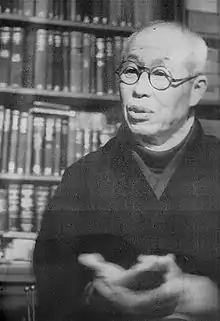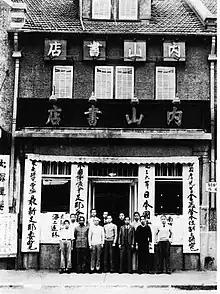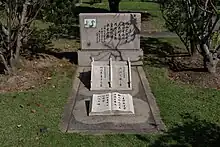Kanzō Uchiyama | |
|---|---|
 Kanzō Uchiyama, 1953 | |
| Born | January 11, 1885 |
| Died | September 21, 1959 (aged 74) |
| Nationality | Japanese |
| Occupation | Proprietor of the Uchiyama Bookstore |
| Known for | Frequent visitors from both Chinese and Japanese intellectuals before World War II
Pioneer to Japan-China Friendship Honorable friend to Lu Xun |
| Spouse |
Inoue Mikiko (1893–1945)
(m. 1916; died 1945)Kato Masano (m. 1950) |
Kanzō Uchiyama (内山 完造, Uchiyama Kanzō, January 11, 1885 – September 21, 1959), also known with his Chinese name (鄔其山; Wū Qíshān), was the proprietor of the Uchiyama Bookstore, whose frequent visitors were both Chinese and Japanese intellectuals before World War II. Uchiyama was a Christian.
Biography
Early life
Kanzō Uchiyama was born in 1885, in the village of Yoshii in Shitsuki District, Okayama. His father was the village headman and a member of the village assembly,[1] while his mother also came from a scholarly family,[2] and he was the oldest among four brothers and three sisters.[1] During his school years, he was a rebellious student who often fought with his classmates and even teachers, and as a result was deemed a problem student by his father and the school and eventually dropped out.[3]
At the age of 12, he was sent out for his apprenticeship to Osaka. To make a living, Uchiyama did many physically demanding jobs in Osaka, doing part-time work at factories and delivering goods for shops.[2] In 1901, he went to work for a textile wholesaler in Kyoto and worked there for ten years.[1]
At the age of 27, Uchiyama became a Christian. In 1912, Uchiyama first encountered Christianity. On January 31, with suggestions from Kotani Shōzaburō, a colleague of his, Uchiyama walked into Kyoto Church, where he met three people whom he sees as role models. Uchiyama laid his foundation and faith for mission in Kyoto Church with connections to Niijima Jō, founder of Dōshisha University,[1] who taught many graduates including Makino Toraji, a Pastor at Kyoto Church, who eventually became a life-long mentor of Uchiyama.[1]
Early career
In 1913, Taguchi Kenkichi, a member of the church, the founder of Osaka-based pharmaceutical company Taguchi Santendō, later known as Daigaku Megusuri Santendo. Taguchi asked Pastor Makino to find a member on a mission to sell Daigaku mekusuri (University Eye Medicine) in China. Uchiyama dislikes the environment where individuals have to lie in the Japanese business force at the time, thus with Pastor Makino’s persuasion, Uchiyama, at age 28, set off for Shanghai on March 24, 1913.[3] The third role model Uchiyama sees is Uchimura Kanzō, a pacifist who releases monthly Christian magazines.[1]
Inoue Mikiko, aka Miki, was Uchiyama’s first wife, also a member at Kyoto Church. Miki’s father, an entertainer, became heavy in debt as a gambler. After Miki’s sister passed, the debt is on her shoulders. With the debt on her shoulders, draws her to the Bible and Christianity. When Taguchi Kenkichi asks Pastor Makino to find a wife for Uchiyama, Pastor Makino introduces Miki.[1] Miki and Uchiyama quickly drawn to each other for having tyrannical or abusive fathers, and does not have a childhood. They were engaged on February 9, 1915 The couple married on January 9, 1916.[3]
Shanghai and the Uchiyama Bookstore

Soon after getting married, Uchiyama and his wife returned to Shanghai from Japan for his work.[3] Uchiyama's job required him to travel frequently between various cities in China, leaving his wife alone at their home in Shanghai, in which in a country whose language she doesn't know.[3] Due to his upbringing, his wife wanted to contribute to the family and have an additional source of income. Moreover, Uchiyama did not want his wife to play the traditional role of a housewife merely. Therefore, the couple decided to open a Christian bookstore managed by Uchiyama's wife.[2] They opened their Christian bookstore in their Shanghai home in Weishengli, Lane 1881, North Sichuan Road in 1917.[4] The bookstore has size of eight-mat room, roughly 144 square feet, about the size of a single undergraduate’s unadorned room; it had a tiny attached kitchen and a second floor with an eleven-mat room. This bookstore is nominal to Japanese people living in Shanghai at the time, for there were only 3 other Japanese-run Bookstore in Shanghai: Nihondō, Shinkōdō, and Shiseidō. Additionally there were no bookstore specifically carry Christian Books written in Japanese, so the Uchiyama Bookstore becomes popular among Japanese Christians residing in Shanghai. As the word spreads, Chinese and Koreans who read Japanese visited the store.[3] The North Sichuan Road train line extends from downtown Shanghai to the International Settlement.[4] In order to accommodate the growth of demand of materials, in terms of customer number and range, in 1929, the bookstore moved to 2048 North Sichuan Road. Uchiyama even installed a telephone to take orders from all over China via the postal service.[3] This location remained Uchiyama Bookstore and salon until Chinese government requisitioned on October 23, 1945.[4]
From 1923, Uchiyama's bookstore became a meeting place for Chinese and Japanese cultural figures, which Uchiyama named the "Mandan", and gradually developed into a meeting point for revolutionary forces. [5] Uchiyama Shoten has not only been a platform for the growth of new culture in China, but has also contributed to the development of the Chinese and Japanese editing and publishing industries, and has become an important link for book publishing and cultural exchanges between the two countries.[6]
Pioneers of Japan-China Friendship
As a Christian, Uchiyama's worldview and behavior contrasted sharply with that of his fellow Japanese.[1] Uchiyama's membership in the Christian community not only fulfills his spiritual needs, but also facilitates cross-cultural exchanges and understanding between Chinese and Japanese people. This has played a positive role in bridging the friendship between the two peoples.[1]
In the 1920s, thanks to Uchiyama's introductions, an increasing number of Japanese artists and intellectuals came to Shanghai. They interacted with Chinese literati, providing a platform for sharing information and fostering connections between Chinese students in Japan and Japanese writers traveling to Shanghai, all while cultivating profound friendships. Some of the notable individuals in this network included Tanizaki Junichirō, Kaneko Mitsuharu,Komaki Ōmi, Satomura Kinzō among others.[4] These Chinese literati included Guo Moruo, Tian Han, Chen Baoyi, Feng Guangtao, Ouyang Yuqian, Yu Dafu, Wang Duqing, Cheng Fangwu and others.[4] It is for this reason that Uchiyama Bookstore has become a fashionable venue for Sino-Japanese cultural exchanges in Shanghai, and has risen to become one of the most famous bookstores in Shanghai, gathering Chinese and Japanese scholars and writers.[1]
Uchiyama and Lu Xun

Uchiyama was a great and loyal friend to Lu Xun. Uchiyama met Lu Xun in 1927, Lu Xun has a distinctive term for Uchiyama, calls him laobe, meaning “boss/proprietor” in Shanghainese, laoban in standard Mandarin. Uchiyama respects Lu Xun as sensei, meaning "teacher" in Japanese. Both of them are concerned with Sino-Japanese relations, while Uchiyama much more than Lu Xun, for he utilizes the bookstore as a salon, a medium for promoting Japan-China Friendship.[7] Fogel quotes "I am often tempted—but only tempted—to suggest that their friendship may have been based solely on Uchiyama’s extraordinary help in protecting Lu Xun (and Xu Guangping and their child) on numerous occasions, even at the potential risk of his own life, and Lu Xun’s equally extraordinary sense of gratitude."[7]
After Lu Xun delivered his views after founding League of Left-Wing Writers, Zhejiang branch of the GMD issued an arrest warrant for him in late March 1930. Uchiyama and Miki helped Lu Xun’s family to hide on the second floor of the Uchiyama Bookstore for a month. In May, Uchiyama moved Lu Xun's family to the second floor of the Ramos Apartments (now Chuanbei gongyu), as it would be unsafe for Lu Xun's family to live in a bookstore with Chinese customers come and go, not to neglect the fact of GMD spies. Uchiyama rented the flat under his name to protect Lu Xun. In January 1931, many of the young leftist and Communist writers were arrested by the GMD. Lu Xun was severe in danger. Uchiyama assisted to find Lu Xun's family a residence in Huayuanzhuang, an apartment belonged to Yoda Hōban, one of his Christian friends resided in Shanghai. This place was ideal for GMD less likely were able to arrest or assassin Lu Xun in foreign owned places. A month or two later in February or March, Lu Xun wrote a poem simply named “Zeng Wuqishan” (A Poem Presented to Uchiyama) to thank Uchiyama's help being such an honest and helpful friend.[7]
By 1932, Uchiyama had become the sole publisher of Lu Xun's works. By April 1933, Lu Xun's family moved to Scott Road, just blocks away from Uchiyama Bookstore, with expenses all under the bookstore. This is the place Lu Xun spent his last three years of life, and this location eventually became the residence to Lu Xun Memorial Museum.[7] After Lu Xun's death in 1936, Uchiyama did not give up on the publication of Lu Xun's writings and compilations. It was Uchiyama's dedication that earned him the prestigious status of "administrator of Lu Xun's legacy" in the cultural circles of both China and Japan. To this day, Mr. Uchiyama's name, "Friend of Lu Xun," is still remembered by future generations. Uchiyama's efforts to disseminate and protect Lu Xun's writings have resulted in a remarkable friendship.[8]
Later Years
Uchiyama celebrated thirtieth wedding anniversary with wife Miki on January 9, 1945. Uchiyama celebrated his 60th birthday on the 11th, his kanreki, meaning to start life again at 60 in Japanese. Sadly, Miki passed away just 2 days later on the 13th. Uchiyama felt grieve and ponder through the next phase of his life. Seeing his friend in grief, Tsukamoto Suketarō, one of his close friends suggested Uchiyama build a double grave so that he and Miki would be buried together. Uchiyama had epitaph inscribed. After Japan's surrender in August, Uchiyama Bookstore remained open until October 23, 1945. Uchiyama deported back to Japan in 1947.[9] After the war, he became the first head of the Japan China Friendship Association.[10]
After WWII, Japan was defeated. The Chinese government immediately nationalized Uchiyama's bookstore and deported Uchiyama himself. Uchiyama had to return to Tokyo, Japan, where he began a new life. He worked for a while at the Tokyo branch of Uchiyama Shoten and continued to promote friendly relations between China and Japan through the publication of the magazine "Mandan".[9]
The Japan-China Friendship Association (JCFA) established on October 1, 1950 in Tokyo. He was the first Chairman of the association. He also was the founding member of the Japan-China Trade Promotion Association.[10] The same year, Uchiyama married Kato Masano from Moji, a port city connected with Nagasaki. Masano is Miki’s friend, they were former women of the entertainment district. After their marriage, Uchiyama and Masano moved in Kyōdō kita area of Tokyo’s Setagaya ward. They join the United Church of Christ near their home, with Murata Masasuke, Uchiyama’s old friend in Shanghai being the Pastor.[9]
During the period from 1949 to 1972, Uchiyama, as a director of the JCFA, visited China many times to communicate with Chinese intellectuals despite the fact that China and Japan had not yet established formal diplomatic relations. Under the very sensitive and complicated environment of the relationship between the two countries, Uchiyama, despite all the difficulties and obstacles, actively promoted cultural exchanges and friendly exchanges between Chinese and Japanese people. Uchiyama often hosted visitors from China in JCFA, including Li Dequan, Liao Chengzhi, Guo Moruo, and Xu Guangping.[9]
Death and Burial

On September 21, 1959, Kanzō Uchiyama passed away in Beijing. He is buried in the Shanghai Wanguo Cemetery. At his funeral, attendees included Ouyang Yuqian, and others, among whom Tian Han was also present.[11]
Notable Works
"Thirty Years" 1947
Friends with the Same Blood Running Through (Onaji chi no nagare no tomo yo) 1948
China’s Past and Present (Heikin yūsen: Chūgoku no konjaku) 1955
Recollections from the Past (Kakōroku)
Further reading
- Keaveney, Christopher T. “Literary Interventions: Yamamoto Sanehiko’s Contributions to Sino-Japanese Literary Exchange in the Interwar Period.” Modern Chinese Literature and Culture, vol. 22, no. 2, 2010, pp. 196–230. JSTOR. Accessed 27 Nov. 2023
- Kato, N., & Grunow, T. (2017, December 29). Meiji at 150 Podcast, Episode 012, Dr. Naoko Kato (University of British Columbia).
- Seraphim, Franziska. "People’s Diplomacy: The Japan-China Friendship Association." War Memory and Social Politics in Japan, 1945–2005. Harvard University Asia Center, 2006.
- Fogel, Joshua A. "Japanese Literary Travelers in Prewar China." Between China and Japan. vol. 7, BRILL, United States, 2015.
- Fogel, Joshua A. "The Recent Boom in Shanghai Studies." Journal of the History of Ideas, vol. 71, no. 2, 2010, pp. 313-333.
- Fogel, Joshua A. A Friend in Deed: Lu Xun, Uchiyama Kanzō, and the Intellectual World of Shanghai on the Eve of War. Association of Asian Studies, Ann Arbor, MI, 2019.
- Kato, Naoko, Marcia A. Johnson, and ProQuest (Firm). Kaleidoscope: The Uchiyama Bookstore and its Sino-Japanese Visionaries. Earnshaw Books Ltd, Hong Kong, 2022.
See also
References
- 1 2 3 4 5 6 7 8 9 10 Kato, Naoko (2022). "First Turn of the Kaleidoscope - A Christian Bookstore". Kaleidoscope. United States: Earnshaw Books Ltd. pp. 1–6.
- 1 2 3 Keaveney, Christopher T (2009). "The Hub: Uchiyama Kanzō 's Shanghai Bookstore and Its Role in Sino-Japanese Literary Relations". Beyond Brushtalk: Sino-Japanese Literary Exchange in the Interwar Period. Hong Kong: Hong Kong University Press. pp. 23–44.
- 1 2 3 4 5 6 7 Fogel, Joshua A. (2019). "Background: Uchiyama and Shanghai". A Friend in Deed: Lu Xun, Uchiyama Kanzō, and the Intellectual World of Shanghai on the Eve of War. Vol. 3, number 3. Association of Asian Studies, Ann Arbor, MI. pp. 15–20.
- 1 2 3 4 5 Kato, Nakao (2022). "Fourth Turn of the Kaleidoscope - A Sino-Japanese Cultural Salon". Kaleidoscope. United States: Earnshaw Books Ltd. pp. 1–13.
- ↑ 姜, 秀花 (2009). "内山完造及其内山书店". 高校图书馆工作. 29 (4): 68–70.
- ↑ 吕, 慧君 (2021). "从外国文化输入到中国文化输出:上海内山书店在中日出版文化交流中的媒介性研究". Bian Ji Zhi You (4): 106–112.
- 1 2 3 4 Fogel, Joshua A (2019). "Lu Xun and Uchiyama Kanzō in Shanghai". A Friend in Deed: Lu Xun, Uchiyama Kanzō, and the Intellectual World of Shanghai on the Eve of War. Vol. 3, number 3. Association of Asian Studies, Ann Arbor, MI. pp. 29–37.
- ↑ 高纲, 博文 (2002). "上海内山书店小史". 档案与史学 (4): 63–77.
- 1 2 3 4 Kato, Nakao (2022). "Seventh Turn of the Kaleidoscope - Japan-China Friendship Association". Kaleidoscope. United States: Earnshaw Books Ltd. pp. 1–17.
- 1 2 Scott, Paul. Uchiyama Kanzo: A Case Study in Sino-Japanese Interaction (PDF). Kansai University of Foreign Studies. p. 50.
- ↑ Kato, Naoko (2022). "Eighth Turn Of The Kaleidoscope -The Uchiyama Bookstore and its Sino-Japanese Visionaries.". Kaleidoscope. United States: Earnshaw Books Ltd. pp. 94–96.